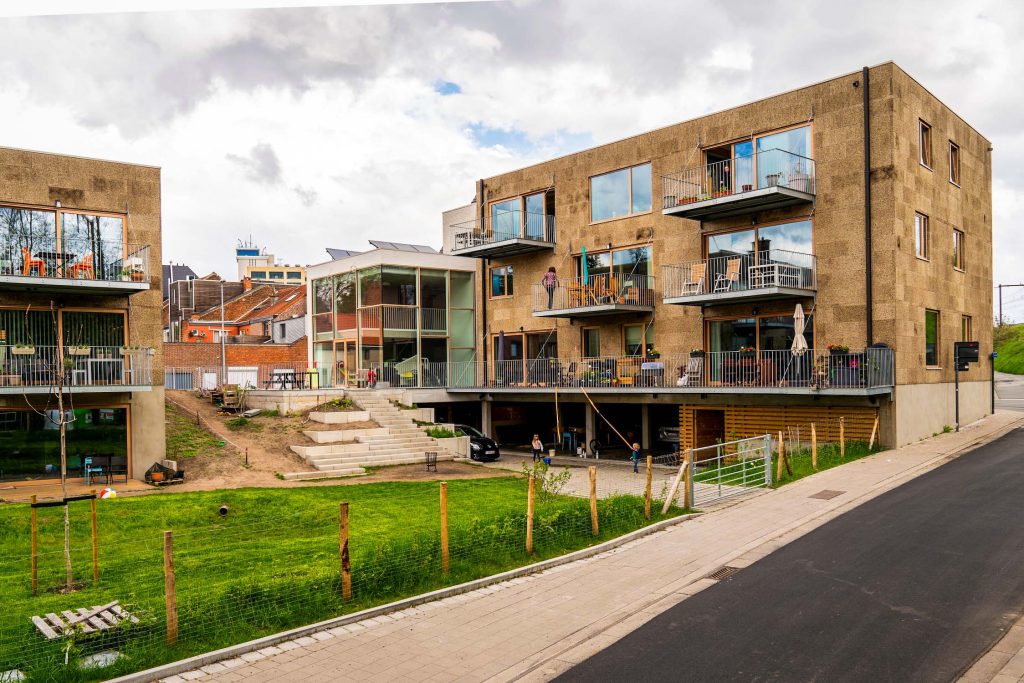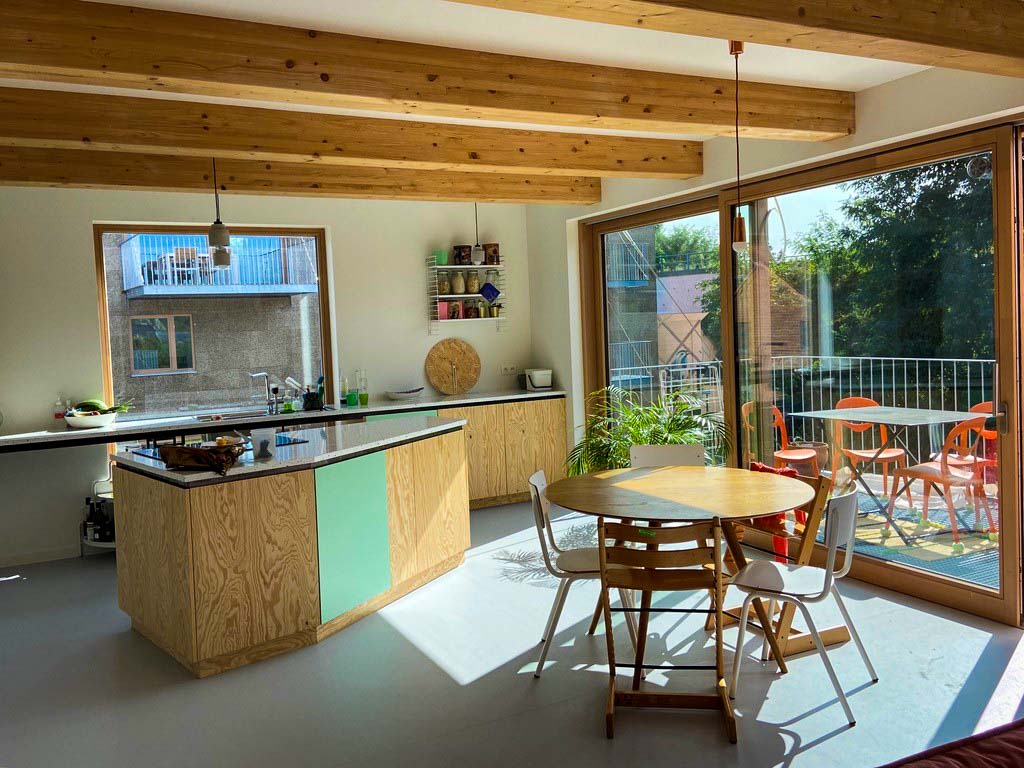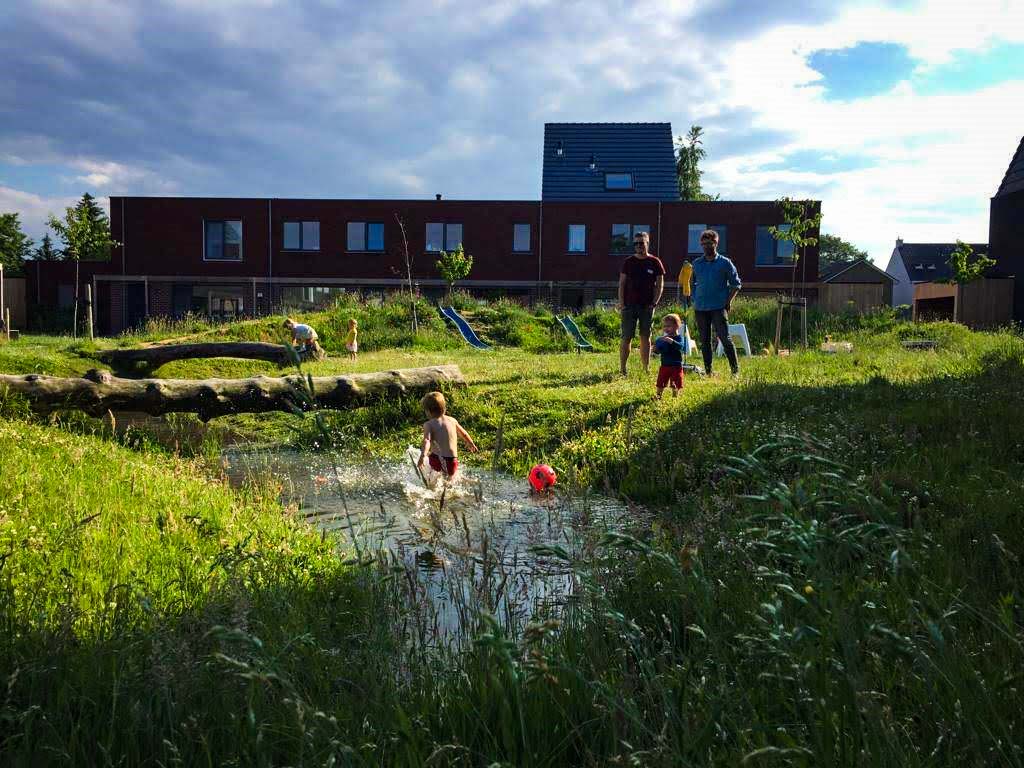Have you ever heard of cohousing? This alternative living model promises to combine privacy and community, use space efficiently, and provide plenty of greenery. Eef Tanghe, CityChanger and founder of Cohousing Projects, makes the case for cohousing and highlights the importance of knowledge sharing.
A block of flats. Each flat contains a washing machine that is used once, maybe twice a week. Each resident owns a car. Instead of a garden, there is a huge car park in front of the block. No one knows their next-door neighbour.
This is what CityChanger Eef Tanghe wants to change. She is the founder of Cohousing Projects, a company helping individuals and groups to realise cohousing schemes.
Cohousing is a type of community-led housing, where a group of people co-design homes and form a community. Each resident lives in their own unit, but there is a particular focus on incorporating shared spaces, like a communal kitchen or a co-working space. Every cohousing project is unique and defined by its residents and their needs.
The general aim is for people to live within a thriving community, where everyone has their privacy (i.e., a fully equipped flat/house) but shares other resources efficiently. In a cohousing community, Eef tells us, not everyone needs to own a washing machine or a lawnmower. If wanted and decided upon by the community, these appliances can be shared.
The same goes for cars. In cohousing complexes, parking spaces are located either underground or on the edge of the site. That’s why many cohousers, i.e., residents of cohousing complexes, opt for carsharing. Eef explains: “We can see that a lot of people start sharing cars because they can physically see cars standing there the whole day, wondering: ‘How come we have ten cars standing still the whole day? Can we not share a car because I need the car at the weekend, and you need it during the week?’”


Another key element of cohousing complexes is the focus on greenery. Since cars are parked a little way off, the space around and between buildings can be used as a large communal garden, where kids can play and residents can come together to chat. However, social interaction is an option, not a must, as Eef stresses.
“It’s nothing like Friends or Melrose Place, or the kind of series people refer to. You have your own privacy. Privacy is very important.”
The Case for Cohousing
Cohousing offers many benefits. Space is used more efficiently since individual units are smaller than usual homes and residents share certain amenities. Cohousing projects boast green spaces and – as cars do not enter the complex – parents can let their kids play outside without having to worry. Another huge bonus is that cohousing encourages social interaction. This makes it ideal for young people and professionals looking for friends as well as elderly people who otherwise often experience loneliness.
All of these benefits combined, cohousing could work like magic when it comes to bringing people back to city centres and introducing more density to limit sprawl. Our CityChanger elaborates:
“The way to get people back to the city is to give them the same qualities as a house in the suburbs. So, they need a place for kids to play. They want contact with other parents and other people. If you have these advantages of the suburbs, and you can make them happen in the city, people are very fond of moving back to the city.”
Cohousing Projects: A Cohouser’s Helping Hand
Like many community-led housing schemes, cohousing projects are quite tricky to implement. Groups are often in need of expert advice as they navigate through bureaucracy, architectural details, and financing options. Cohousing Projects lends residents a hand. It provides advice and guidance where needed and helps groups “get started very fast and without any bumps in the road”.
Eef and her team coach future cohousers in group decision-making, help them calculate a realistic budget, explain legal aspects, and match them up with architects and developers. Cohousing Projects also buys land and starts its own projects or offers it to cohousing groups in the making who would otherwise struggle to purchase a plot. Once the complex has been built and the group has gathered enough money, it can buy the land from the company. This reduces initial financial hurdles and massively speeds up the process.
How It All Began
So, how did Eef become a cohousing expert? She has implemented (and currently lives) in a cohousing project herself.
A good ten years ago, Eef found herself in a tight spot. She lived in a small flat in Ghent, in a street where neighbours knew and helped each other. However, she outgrew her apartment and was forced to look for something else. The problem: where would she find neighbours as nice as hers? The solution: Eef took to the internet and stumbled across a cohousing group forming in Ghent. United by the idea that community was just as important as privacy, they started their project. Eef laughs and confesses: “At first, I was a bit afraid I would end up in some kind of hippie community,” and then she adds, “but it turned out that those people were very pragmatic and very down to earth”.

Once they had successfully completed their project, Eef and her fellow cohousers received a lot of visitors. Eef recalls: “They asked us: ‘How did you do this? How? Because we’ve been trying for years, but we don’t have any time because we are working. We cannot have any meetings with the municipality or with the fire department to discuss our plans. And we don’t have all the knowledge to start this project.’”
These visits and questions led Eef, who at the time was working as a journalist, to gradually immerse herself in the cohousing business. She and a couple of fellow residents started offering advice to other building groups – initially only at the weekends. However, they soon decided to step up their game and founded Cohousing Projects.
Ways to Get Started
The Cohousing Projects team currently consists of only four people. Over the past eight years, they have helped realise 15 projects, and another ten are being built right now. They also have five to ten projects in the pipeline.
Each scheme is unique, but Eef explains that most of them start in a similar way. According to our CityChanger, there are three routes via which a project can be launched:
1. The Group Approach
Looking for a different way of living, people – maybe friends – come together and decide to build a cohousing complex. Eef and her team have often been approached and asked for help by such groups. However, only rarely did their input lead to success. Working with already existing cohousing groups is tricky, Eef explains.
“It’s strange to say it as a company that builds group projects, but groups don’t exist.”
Group members may be united by shared interests or even friendship; however, simple tasks like picking a plot become difficult very easily. “For one person, the project is too expensive. For the other person, it is too far from their kids’ school. For the other person, it’s too noisy because it’s next to a railway station.” Ultimately, many groups break up and the project goes to waste.
2. The Site Approach
The most efficient way to start a project, Eef reveals, is by purchasing a site and then reaching out to potential residents. That way, you only attract people who are genuinely interested in living in a certain location and the concept of cohousing.
3. The Competition Approach
Building competitions often inspire cohousing projects. The city authority advertises a particular plot of land and groups can put forward ideas on how to develop it. If the chosen group opted for a cohousing project, they can seek the advice of Eef and Cohousing Projects.

The Challenge
What all approaches have in common is that they are relatively risky, time-consuming, and intense. Implementing a cohousing project often takes three to four years.
In the future, Eef and her team want to make things easier for building groups. “The challenge for us now is to find solutions to make it less intense.” To tackle this challenge, they constantly evaluate past projects and consult the groups they have helped. “We ask our groups, ‘so what was the biggest challenge for you? What could make it easier?’ So, then we take the next steps to help more projects get developed.”
Cohousing Projects also encourages and facilitates the exchange between the groups they have supported. They host regular masterclasses, i.e., learning events where residents can share their cohousing experiences and learn new skills.
Top Tip
Likewise, Eef is happy to share a key piece of advice with other CityChangers wanting to launch cohousing projects: don’t bend. “In Ghent, where our company is situated, we have a term that says “nie pleuje”, that means don’t bend. So, it means you will have all kinds of difficulties, but you will get through it, there’s a solution for every problem. So, don’t hesitate to rethink, to redesign, to retry, and to just go for it. And if someone says, ‘no, it won’t work’, then you have to look for people who can maybe help you make it work.”


